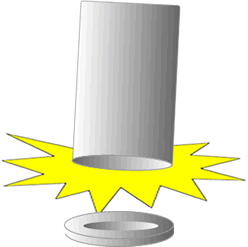Materials(requirents):-
- A regular plastic drinking straw
- 3 X 5 inch index card or stiff paper
- Tape
- Scissors
Experiment:-
1. Cut the index card or stiff paper into 3 separate pieces that measure 1 inch (2.5 cm) by 5 inches (13 cm.)
2. Take 2 of the pieces of paper and tape them together into a hoop as shown. Be sure to overlap the pieces about half an inch (1 cm) so that they keep a nice round shape once taped.
3. Use the last strip of paper to make a smaller hoop, overlapping the edges a bit like before.
4. Tape the paper loops to the ends of the straw as shown below. (notice that the straw is lined up on the inside of the loops)
5. That's it! Now hold the straw in the middle with the hoops on top and throw it in the air similar to how you might throw a dart angled slightly up. With some practice you can get it to go farther than many paper airplanes.
How does it works:-
Can we really call that a plane? It may look weird, but you will discover it flies surprisingly well. The two sizes of hoops help to keep the straw balanced as it flies. The big hoop creates "drag" (or air resistance) which helps keep the straw level while the smaller hoop in at the front keeps your super hooper from turning off course. Some have asked why the plane does not turn over since the hoops are heavier than the straw. Since objects of different weight generally fall at the same speed, the hoop will keep its "upright" position.










